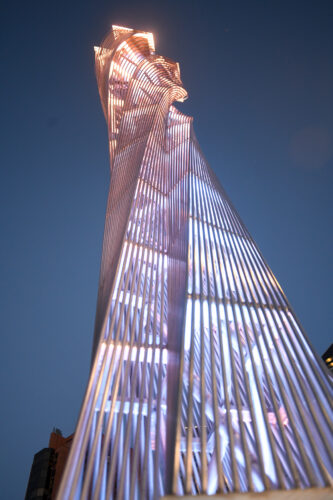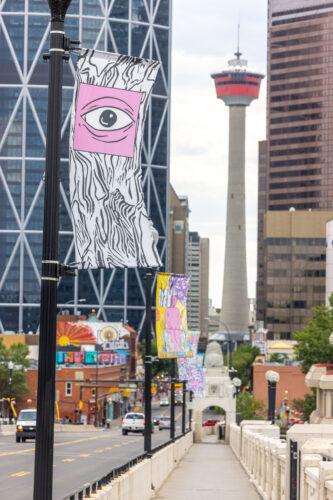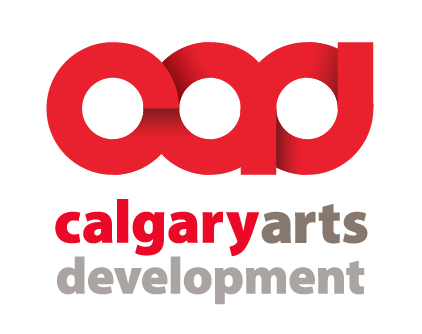Organization
Calgary Arts Development Authority (CADA) is Calgary’s designated arts development authority, providing grant investments to hundreds of arts organizations, individual artists, and groups while facilitating the public art program. Through the arts development strategy, Living a Creative Life, the organization’s vision is a creative, connected, prosperous Calgary where every resident has the opportunity to live a creative life. CADA’s strategic framework, Ákáakomatapoap, a Blackfoot word meaning We are now going to begin recognizes the transformational times the arts face. The four guiding pillars in the framework include Purpose, People, Community and Resources.

The City of Calgary (The City) assumed custodianship of the public art collection in 1982, and is responsible for the development, maintenance, and promotion of the collection. Roughly 80% of Calgary’s public art collection was built by the generosity of individuals, businesses and charitable organizations which gave and loaned to The City, and its affiliates, numerous artworks for places such as the Centennial Planetarium, the Devonian Gardens, Century Gardens, the Calgary Zoo, and Heritage Park. In 2004, City Council approved a Public Art Policy, and a program was created to deliver broad based public art programming, installation of permanent artworks and conservation of public art assets on behalf of Calgarians.
In March 2021, The City announced Calgary Arts Development as the new commissioning arm for Calgary’s public art program. Since that time, Calgary Arts Development has been working with The City on the transition of the program; The City funds public art, CADA commissions new work, and The City is responsible for the conservation and care of the collection on behalf of Calgarians.
As the city’s arts development authority, Calgary Arts Development is uniquely positioned to deliver and create a future public art program built upon our knowledge of, and strong relationships in the arts community. CADA envisions a public art program rooted in meaningful engagement that tells the story of who we are and what is valued as a city. CADA envisions public art that Calgarians can connect with throughout the city; a program that reaches everywhere and everyone. It is a program that is engaging, relevant and accountable to The City and to Calgarians. A public art program for Calgary must reflect the rich diversity of the city, including connecting with Indigenous voices to tell the past, current and future stories of Calgary (Moh’kinsstis). CADA is committed to working with communities that have historically been underserved, and is guided by the core values of equity, diversity, inclusion, and accessibility.
Program goals include streamlining processes so it is easier for artists to apply and ensuring that local artists are aware of opportunities to participate. CADA sees the importance of creating connections between international artists and local artists to build capacity as well as shedding light on the many processes surrounding public art, and its value and impact on the city. CADA’s intent is to foster meaningful connections and dialogue between artists and communities, ensuring art in the public realm reflects Calgary’s diverse stories and values.
Currently, there are 40 projects at different stages of development anticipated to be completed by the end of 2026. This includes works like The Bison and The Dragon: Untold Tales, a public art project in Chinatown by artist Jarett Sitter, which represents a history of collaboration and shared adversity between local Chinese and Indigenous communities. Other works are in a wide variety of forms and media and employ artists from a range of local, national, and international locations and of diverse backgrounds, including a notable number and range of opportunities for Indigenous artists. At the centre is a commitment to community engagement and good relations. CADA has developed and follows its own procurement process, which fulfills requirements designated by The City.
CADA has a 14-member board of directors led by chair Chima Nkemdirim, a public art committee guided by chair, Jeff DeBoer, and a team of four directors led by President and CEO Patti Pon. For the fiscal year ending December 31, 2024, CADA anticipates a total of $20.8 million in revenues with the operating budget for the public art department anticipated to be $920,000 and between $4.3 million and $5.5 million estimated annually for capital investment on public art projects and initiatives through 2026.
Community
CADA acknowledges that the land gathered on, Moh’kinsstis, is the ancestral territory of the Siksikaitsitapi—the Blackfoot people—comprising the Siksika, Kainai, and Piikani Nations, as well as Treaty 7 signatories, the Tsuut’ina Nation, and the Îyârhe Nakoda Bearspaw, Chiniki, and Goodstoney First Nations. This land is also the home of Otipemisiwak Métis Government Districts 5 and 6 as well as many First Nations and Inuit from across Turtle Island. We acknowledge that there has been art, music, dance, storytelling, and ceremony on this land since time immemorial and it is in the spirit of this land and its people that CADA undertakes its work.
Known today as Calgary, the largest city in the Province of Alberta, the area includes a population of 1.4 million people. Alberta has a population of approximately 4.7 million people, making it the fourth largest of Canada’s 13 provinces and territories. Known for its ongoing commitment to reconciliation and cooperation with Indigenous peoples, vibrant economy, and incredible landscapes, the province is seen as a place of opportunity.

Calgary boasts a high standard of living and an array of amenities. The city serves as a thriving business hub, particularly in the energy industry, as well as in the technology, finance, and healthcare sectors. Its international airport connects the city to key destinations around the world. With the Rocky Mountains only a short drive away, outdoor enthusiasts can easily access hiking trails, skiing resorts, and some of the greatest landscapes in the western hemisphere. Additionally, the city boasts an extensive pathway system that promotes cycling, jogging, and walking, making it easy for residents to maintain an active lifestyle. The city is home to several world-class universities, colleges, and schools, providing access to top-notch education and fostering a culture of learning and innovation. Calgary is the third most diverse city in Canada and CADA is committed to ensuring the public art program tells the stories that reflect the people who call this city home.
Calgary's art and culture scene offers a diverse array of organizations and artists, enriching the city's cultural landscape. As an arts funder, CADA grants to hundreds of arts organizations, individual artists, arts collectives, festivals, and events. Alberta Ballet is one of Canada’s foremost ballet companies. The Glenbow Museum, undergoing a major renovation of its spaces, houses extensive collections of art, history, and Indigenous belongings. Calgary is an emerging music city housing the National Music Centre, exceptional philharmonic and opera companies, an extensive choral music community and numerous popular live music venues. Calgary is known for new play development and is home to many outstanding theatre companies that stage compelling theatrical productions. Modern and contemporary art is exhibited by both Contemporary Calgary and the Esker Foundation. There is also a plethora of arts and cultural festivals throughout the year including the High Performance Rodeo, Chinook Blast, the Calgary Folk Music Festival, and many more. Calgary is also a burgeoning centre for film and television production.
Sources: regionaldashboard.alberta.ca; calgaryartsdevelopment.com; calgary.ca
Position Summary
The role of the Public Art Director (Director) is to provide creative and executive leadership of the commissioning, programming, and community engagement practices of the public art program. Reporting to the President and CEO, the Director provides oversight for all financial and operational functions of the program. Leading a full-time staff and contracted project leads and curators, it is essential that the Director effectively communicates the value of public art to the public, and parties of interest, serving as a respected thought leader in building a vibrant, energetic community. Nurturing good relations throughout the community, and notably with Treaty 7 Nations and Indigenous artists, the Director serves as the primary public face of the program to The City and the wider community.
Roles and Responsibilities
Program Vision and Leadership
- Inspire the CADA team in the development and delivery of the program vision and strategy.
- Assure that the implementation of the public art program responds to the Calls to Action of the Truth and Reconciliation Commission and the White Goose Flying Report.
- Advance strategies in collaboration with the CADA leadership team across all operational and programmatic areas.
- Mentor, motivate, and lead the public art team, nurturing their personal and professional development and growth.
- Orchestrate program goals and priorities as per the contractual agreement between CADA and The City and in alignment with CADA’s vision, mission, and values.
- Collaborate with The City’s Public Art team to deliver new artworks that will become part of The City’s public art collection.
- Develop strategic opportunities for integrated public art initiatives through serving as Co-Chair of the Interdepartmental Public Art Team alongside The City’s Public Art Liaison.
- Apply sensitivity to the diverse needs and lived experiences of artists, parties of interest, and the CADA team.
- Negotiate with other relevant parties on project development and realization.
- Support communications and marketing of projects to ensure a strategic approach to disseminating program content.
- Ensure that staff across the programmatic areas generate and contribute content on a timely and regular basis.
- Act as media spokesperson for the public art program as requested.
- Embrace other program vision and leadership responsibilities, as required.
Partnerships and Community Engagement
- Animate the community through an open, transparent, and welcoming public art process that inspires community input and support for public art.
- Develop, establish, and maintain partnerships, as needed, to ensure that projects are realized under the best possible conditions.
- Lead the development of effective partnerships with local, national, and international visual arts communities.
- Cultivate partnerships with Indigenous communities and leadership in the Treaty 7 territory.
- Nurture a positive, symbiotic relationship with City Council and Administration.
- Embrace other partnerships and community engagement responsibilities, as required.
Operational Excellence
- Maintain strong relationship with The City as partners in delivering the program, including regular reporting on key accountabilities and project updates.
- Direct the content and planning of programming decisions, partnerships, co-productions, and commissions.
- Create and manage large, multi-year budgets and work plans for the operations of the Public Art department and all related Capital Projects.
- Develop and update relevant KPIs for the purposes of reporting to various parties of interest including The City, the CADA board, and the community at large.
- Embrace other operational excellence responsibilities, as required.
Traits and Characteristics
The Director has an acumen for building relationships and networks with key people of influence, institutional partners, government officials, and Calgary’s diverse communities. While maintaining a deep sensitivity to the unique needs, interests, and concerns in the public art process, the Director is a visionary, visible, and inspiring leader who is comfortable and keen to work in a deeply collaborative team environment. They can effectively manage multiple, complex tasks on strict budgets and timelines while adapting methodologies with enthusiasm, flexibility, and verve. The Director takes on responsibility for their words and actions, and they have an ability to mediate multiple perspectives with integrity, authenticity, and honesty.
Other key competencies include:
- Leadership and Diplomacy – The dexterity and foresight to anticipate, meet, and exceed a variety of stakeholder and rights holder needs and expectations, inspiring others in effectively handling difficult or sensitive issues which arise in relationships, community and via the media.
- Personal Accountability and Flexibility – The capacity and courage in being answerable for personal actions and readily modifying, responding, and adapting to change with minimal resistance.
- Time and Program/Project Management – The acuity in prioritizing and completing tasks in order to deliver desired outcomes within allotted timeframes related to overall program objectives.
- Decision Making and Conflict Management – The sensitivity in understanding, addressing, and resolving conflict constructively and analyzing all aspects of a situation to make consistently sound and timely decisions.
Qualifications
Executive leadership experience and proven success in a complex public art program with excellent financial acumen is required. Demonstrated success in advancing diversity, equity, inclusion, and accessibility strategies, and for understanding the principles of reconciliation with Indigenous communities, is necessary. Familiarity in leading participatory community engagement practices and processes is needed. Strong expertise and passion for working with artists and in communicating the value of public art to diverse parties of interest and the public is expected. Excellent written and communication skills, in English, are required.
Compensation and Benefits
CADA offers a competitive salary estimated in the range of $120,000 to $140,000 with a contribution to relocation, if needed. CADA further provides an extended health benefits package which includes dental, life insurance, and health spending account. There is an annual professional development allowance. Staff work in a hybrid environment and are encouraged to be in the office a minimum of two days per week. The position includes 20 days' vacation in the first year, plus time off during the December holiday season. CADA provides an RRSP matching program of up to 5%.
Applications and Inquiries
To submit a cover letter and resume highlighting relevant and demonstrable accomplishments (electronic submissions preferred), please click here or visit artsconsulting.com/opensearches.
The position announcement is written in English, shared online, and requires applicants to submit applications in English. CADA acknowledges that while this may be a barrier for some potential applicants, English is the most common language in the community, and as the Director is expected to be a strong communicator, this is most equitable approach to the application process. An individual who self-identifies as Deaf/deaf, hard of hearing, has a disability, is living with a mental illness, or is facing language, geographic, or cultural barriers can request assistance by providing name and contact information of an individual who can help. This could be a trusted friend, family member, or a professional service provider. It may be possible to make accommodations depending on the service being requested.
For questions or general inquiries about this opportunity, please contact:
Jeff Erbach, Associate Vice President

1811 4th Street SW, Suite 523
Calgary, Alberta T2S 1W2
Tel (888) 234.4236 Ext. 241
Email CADA@ArtsConsulting.com
CADA acknowledges that the land we gather on, Moh’kinsstsis, is the ancestral territory of the Siksikaitsitapi — the Blackfoot people — comprising the Siksika, Kainai and Piikani Nations, as well as Treaty 7 signatories, the Tsuut’ina Nation, and the Îyârhe Nakoda Bearspaw, Chiniki and Goodstoney First Nations. Today this land is home to the Otipemisiwak Métis Government Districts 5 and 6 as well as many First Nations and Inuit from across Turtle Island.
CADA acknowledges that there has been art, music, dance, storytelling, and ceremony on this land since time immemorial and it is in the spirit of this land and its people that we do our work.
Click here for the downloadable PDF.

